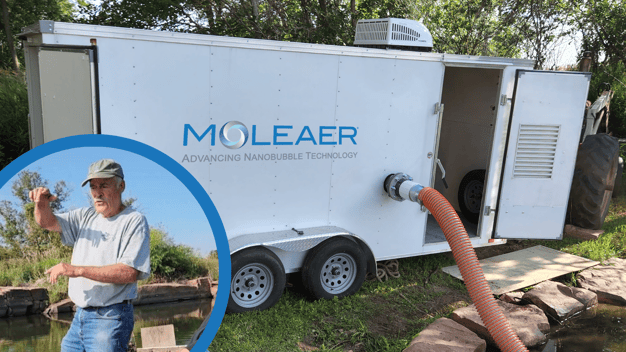What is Muck?
In our blog on “What is muck and how to manage it sustainably in lakes and ponds?”, we answer the question, “What is Muck?” and its negative impacts on water bodies. To recap, muck is a type of organic sediment that can accumulate in lakes and ponds, often consisting of decomposing plant material, algae, and other organic matter.
Muck can proliferate common lake problems like algae, poor water quality, and foul odors. This is because muck can tie up oxygen in the water, leading to low oxygen levels, one of the major factors of water quality. Low oxygen levels are a concern for aquatic life and natural oxidation and digestion processes.
Muck can also release nutrients and pollutants, leading to sediment resuspension, decreased water clarity, and the proliferation of harmful algae. Addressing the challenges of water pollution and muck accumulation is essential for the preservation and restoration of these vital freshwater resources and the protection of the ecosystems they support.

Traditional Muck Control has Drawbacks
From physical to chemical muck control methods, managing excessive muck can be challenging and expensive. One of the most common ways to reduce muck is by dredging or physically removing muck from the bottom of the water body with heavy equipment. This poses risks to the aquatic environment and is also expensive, especially for larger lakes. Chemical control tends to be the other most common option, using algaecides and herbicides for aquatic plant and algae reduction. Pesticides are risky to store and handle and, in most cases, require a license. They can also have negative impacts on the environment if not correctly applied.
Sustainable Muck Control | Cost-Effective & Chemical-Free
In recent years, there has been a trend toward the use of more environmentally friendly and sustainable methods of muck control, such as the use of native plants, natural enzymes, bacteria and nanobubble technology to break down the muck.
Native plants play a crucial role by stabilizing shorelines, filtering excess nutrients, and providing habitat for beneficial microorganisms. Natural enzymes and bacteria, which are often specific to the region, can break down organic matter in the muck, reducing its accumulation and releasing fewer nutrients into the water column. This biological treatment method is not only effective but also environmentally friendly, as it minimizes the need for chemical interventions that can harm aquatic life.
Nanobubble technology can be used alone or complement other natural control methods to create a sustainable lake management plan for keeping muck at bay long-term.
What is Nanobubble Technology?
In contrast to traditional aeration methods, which produce larger bubbles that rise to the surface and burst, nanobubble technology generates extremely small bubbles that remain suspended in water for extended periods. These nanobubbles, measuring less than <200 nanometers in diameter, exhibit properties akin to solid particles and possess a high surface charge that interacts with other substances. When introduced to sediment in lakes or ponds, nanobubbles enhance the oxidation of bad bacteria and decomposition of organic matter in the sediment by providing a source of oxygen for the microorganisms responsible.
Ways Nanobubbles Enhance the Breakdown of Muck in Lakes and Ponds
Enhanced Oxygen Transfer: Nanobubble technology excels at efficiently transferring gas, ensuring the stable penetration of oxygen throughout the sediment layer and the water column. This increased oxygen availability promotes a favorable environment for microorganisms within the sediment, facilitating natural muck digestion.
Increased Microbial Activity: The oxygen supplied by nanobubble technology stimulates the growth and activity of aerobic microorganisms responsible for breaking down organic matter in the sediment. This boost in microbial activity accelerates the rate of muck digestion and reduces muck buildup in the water body.
Minimized Sediment Disturbance: Accumulated sediment at the lake or pond bottom can become unstable and easily disturbed, potentially causing the release of nutrients and pollutants into the water column. By enhancing muck digestion, nanobubbles reduce sediment accumulation and stabilize the sediment, consequently minimizing sediment disturbance.

Moleaer's customer, Vance Walgrave, from Those Blasted Things saw significant muck reduction in his privately owned 30-acre-feet quarry lake after installing Moleaer's patented nanobubble technology.
“We’ve been using this pole to check what’s down in the bottom and originally, there was over one-foot-deep jelly layer with hard sediment down below. Now, the jelly seems to be hardening up and the jelly part has shrunk,” states Vance.
During a 5-week short-term rental, Moleaer's nanobubble technology drastically reduced the thick muck layer, improved water clarity, decreased algae and increased the dissolved oxygen concentration throughout the water body.
Unlike chemical and physical methods, nanobubbles have no adverse environmental impacts. The introduction of nanobubbles to lakes and ponds can promote muck digestion by supplying oxygen to the microorganisms responsible for breaking down organic matter. This results in reduced muck accumulation, improved water quality and a healthier ecosystem. Nanobubble technology proves to be a cost-effective, eco-friendly tool for enhancing the health of lakes and ponds by boosting muck digestion.


